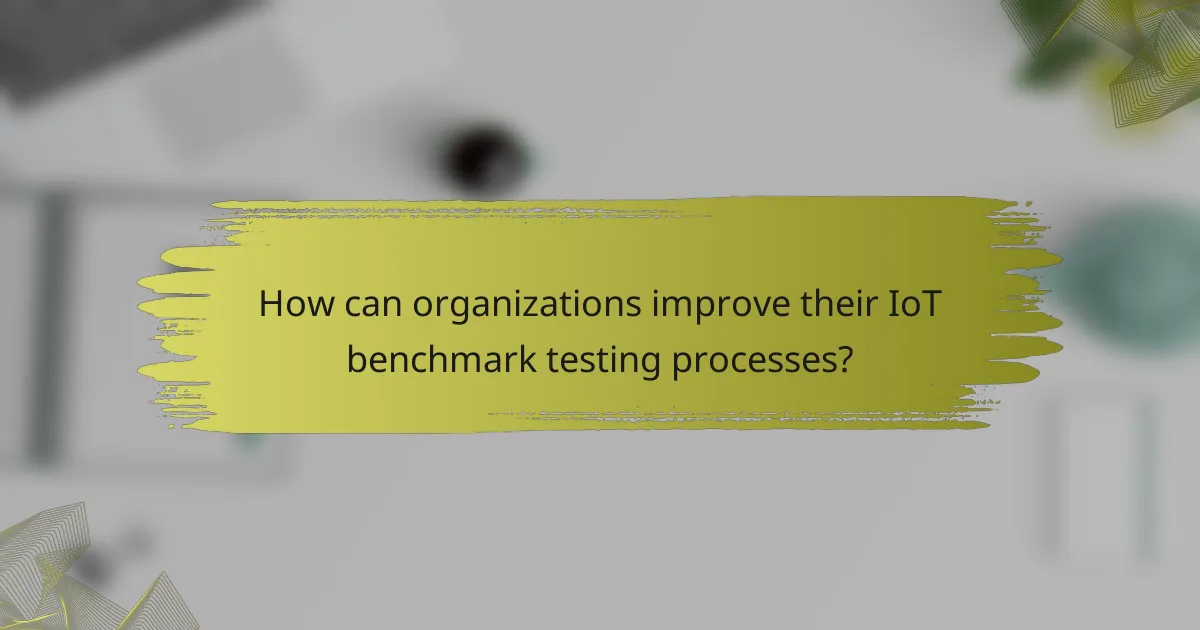Benchmark testing for IoT devices is increasingly focused on enhancing security, leveraging artificial intelligence, and ensuring interoperability in a rapidly evolving landscape. However, companies face significant challenges, including data privacy concerns and a lack of standardized frameworks, which complicate performance evaluations. To overcome these obstacles, organizations are adopting automated tools and realistic testing environments to improve accuracy and efficiency in their testing processes.

What are the current trends in benchmark testing for IoT devices?
Current trends in benchmark testing for IoT devices focus on enhancing security, leveraging AI, integrating edge computing, ensuring interoperability, and utilizing cloud-based platforms. These trends aim to address the unique challenges posed by the diverse and rapidly evolving IoT landscape.
Increased focus on security protocols
As IoT devices become more prevalent, the emphasis on security protocols in benchmark testing has intensified. This includes evaluating encryption methods, authentication processes, and data integrity measures to protect against vulnerabilities.
Testing frameworks are now incorporating security assessments at every stage of the development cycle. For instance, penetration testing and vulnerability scanning are essential practices to identify potential weaknesses before deployment.
Adoption of AI-driven testing methodologies
AI-driven testing methodologies are gaining traction in benchmark testing for IoT devices. These approaches utilize machine learning algorithms to analyze performance data, predict potential failures, and optimize testing processes.
By automating testing scenarios, organizations can significantly reduce the time and resources required for comprehensive evaluations. This allows for more frequent updates and faster deployment of IoT solutions, enhancing overall system reliability.
Integration of edge computing solutions
Edge computing is becoming increasingly important in benchmark testing as it allows for data processing closer to the source. This reduces latency and improves response times, which are critical factors for many IoT applications.
Testing methodologies now include assessments of how well devices perform under edge computing scenarios. For example, evaluating the efficiency of data transmission and processing at the edge can reveal insights into system performance and scalability.
Emphasis on interoperability standards
Interoperability standards are crucial in the IoT ecosystem, as devices from different manufacturers must communicate seamlessly. Benchmark testing now includes evaluations against established standards such as IEEE 802.15.4 or MQTT to ensure compatibility.
Organizations are encouraged to adopt these standards early in the development process to avoid integration issues later. This proactive approach can save time and resources while enhancing user experience across diverse IoT devices.
Growth of cloud-based testing platforms
The rise of cloud-based testing platforms is transforming how benchmark testing is conducted for IoT devices. These platforms offer scalable resources and tools that can be accessed remotely, facilitating collaboration among teams regardless of location.
Cloud solutions enable continuous testing and integration, allowing for rapid feedback and iterative improvements. This flexibility is particularly beneficial for IoT applications that require frequent updates and performance monitoring in real-time.

What challenges do companies face in IoT benchmark testing?
Companies encounter several significant challenges in IoT benchmark testing, including data privacy concerns, a lack of standardized frameworks, the complexity of diverse device ecosystems, and the high costs associated with testing infrastructure. Addressing these challenges is crucial for effective performance evaluation and ensuring reliable IoT solutions.
Data privacy and security concerns
Data privacy and security are paramount in IoT benchmark testing due to the sensitive nature of the information these devices often handle. Companies must ensure that their testing processes comply with regulations such as GDPR in Europe or CCPA in California, which impose strict guidelines on data handling and user consent.
To mitigate risks, organizations should implement robust encryption and anonymization techniques during testing. Regular audits and security assessments can help identify vulnerabilities and ensure that data remains protected throughout the benchmarking process.
Lack of standardized testing frameworks
The absence of standardized testing frameworks complicates IoT benchmark testing, leading to inconsistent results and difficulties in comparing device performance. Different manufacturers may use varying methodologies, making it challenging to establish a common ground for evaluation.
To address this issue, companies can advocate for industry-wide standards and collaborate with organizations like the IEEE or the IoT Security Foundation. Developing internal benchmarks based on best practices can also help create a more uniform approach to testing across different devices.
Complexity of device ecosystems
The complexity of IoT device ecosystems poses a significant challenge for benchmark testing, as devices often interact with various platforms and networks. This interconnectedness can lead to unpredictable performance outcomes, making it difficult to isolate variables during testing.
To navigate this complexity, companies should adopt a modular testing approach, focusing on individual components before assessing overall system performance. Utilizing simulation tools can also help replicate real-world scenarios, providing insights into how devices will perform in diverse environments.
High costs of testing infrastructure
Establishing a comprehensive testing infrastructure for IoT devices can be prohibitively expensive, particularly for small to medium-sized enterprises. Costs can arise from acquiring specialized equipment, software tools, and skilled personnel needed to conduct thorough benchmarks.
To manage these costs, companies can explore partnerships with testing laboratories or leverage cloud-based testing services that offer scalable solutions. Additionally, investing in open-source testing tools can reduce expenses while still providing valuable insights into device performance.

How can organizations improve their IoT benchmark testing processes?
Organizations can enhance their IoT benchmark testing processes by adopting automated tools, utilizing realistic testing environments, collaborating with other entities, and implementing continuous testing practices. These strategies help ensure more accurate results and quicker identification of issues.
Implement automated testing tools
Automated testing tools streamline the benchmarking process by executing tests consistently and efficiently. These tools can simulate various scenarios and workloads, allowing organizations to gather data quickly without manual intervention.
When selecting automated testing tools, consider compatibility with your IoT devices and the specific metrics you want to measure, such as latency, throughput, and resource utilization. Popular tools include Apache JMeter and LoadRunner, which can handle diverse testing requirements.
Utilize real-world testing environments
Testing IoT devices in real-world environments provides insights that lab settings cannot replicate. This approach helps identify performance issues that may arise under actual operating conditions, such as network fluctuations or interference.
To implement this, organizations can set up pilot programs or beta testing phases where devices are deployed in selected locations. Collecting data from these environments can lead to more relevant benchmarks and improved device performance.
Engage in collaborative testing initiatives
Collaborative testing initiatives involve partnering with other organizations or industry groups to share resources and knowledge. This approach can lead to more comprehensive testing scenarios and a broader understanding of device performance across different contexts.
Joining industry consortia or participating in open-source projects can facilitate these collaborations. By pooling expertise and resources, organizations can accelerate innovation and improve the reliability of their IoT devices.
Adopt continuous testing practices
Continuous testing practices integrate testing into the development lifecycle, allowing for ongoing evaluation of IoT devices. This approach helps identify issues early and ensures that performance benchmarks are consistently met throughout the product’s life.
To implement continuous testing, organizations should establish automated testing pipelines that run tests with each code change or update. This not only improves efficiency but also fosters a culture of quality and responsiveness to user feedback.

What are the best tools for IoT benchmark testing?
The best tools for IoT benchmark testing include a variety of platforms that assess device performance, connectivity, and reliability. These tools help developers and engineers evaluate how well their IoT devices operate under different conditions and workloads.
IoT Performance Testing by Keysight
Keysight offers a comprehensive suite of performance testing tools specifically designed for IoT devices. Their solutions focus on evaluating the reliability and efficiency of devices in real-world scenarios, including network conditions and data loads.
One notable feature is the ability to simulate various network environments, which helps identify potential bottlenecks and performance issues. Keysight’s tools are particularly useful for testing devices that require compliance with industry standards, ensuring they meet necessary regulations.
Testbed by IoTify
IoTify provides a cloud-based testbed that allows developers to create and run tests for their IoT applications. This platform enables users to simulate different devices and network conditions, making it easier to assess performance metrics like latency and throughput.
With IoTify, users can quickly set up test scenarios and visualize results, which aids in identifying areas for improvement. The platform is designed to be user-friendly, catering to developers who may not have extensive testing experience, thus streamlining the benchmark testing process.



